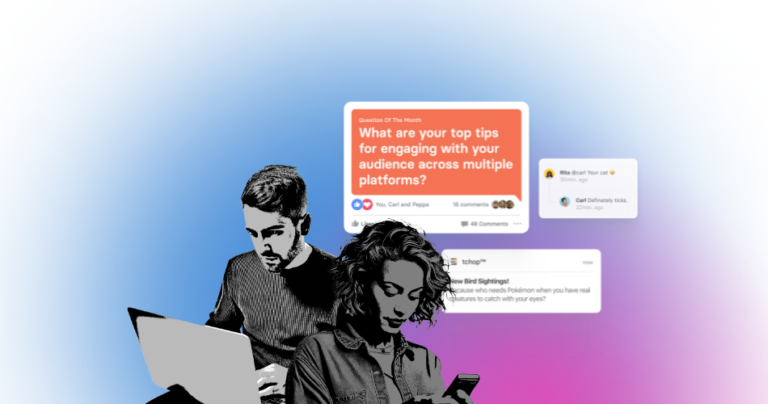Most products get built around this tidy idea: someone opens the app, grabs what they need, closes it. Clean. Simple. Wrong.
People don’t use your product in isolation. Your analytics might show them as lonely dots but in real life they’re tangled up in group chats, work conversations, family threads. Someone reads your article and immediately drops it in the “chaos” WhatsApp group. Someone screenshots a company memo, texts a co-worker: “Is this as bad as it sounds or am I overreacting?” Someone watches your brand video, then sneaks over to check what their friends thought before forming an opinion. An internal announcement lands and within seconds three teammates are in a side chat: “Okay, what’s actually going on here?” Someone’s mindlessly scrolling your app and suddenly shares something to the family group. “Feels like we should talk about this.”
Your product never sees it. Your analytics completely miss it. But it never stops. These tiny conversations create something real, a social layer wrapped around your product whether you planned for it or not. It’s messy, unstructured, doesn’t fit in any feature doc. Lives in DMs, half-baked reactions, late-night voice memos, random “what do you think?” texts, shares that never touch a public feed.
You can see it everywhere once you start looking. Newsrooms publish stories and the real debate happens in locked group chats editors will never read. Brands post content and fans spin up Discord servers to actually talk to each other instead of yelling into official comment sections. Inside companies, employees build whisper networks to decode announcements long before they trust whatever landed in the all-hands deck.
The pattern’s clear. People keep making your product social even when you stubbornly ship it as one-way delivery. They treat what you make as a conversation starter, not an endpoint. That behaviour lives outside your view, grows its own rules, sets its own pace. Not rebellion. Just humans doing what they do: making sense of things together. Don’t give them a place for it inside your product? They’ll find one somewhere else.
Which gets us to the uncomfortable truth: you already have a social layer. It’s running right now, without asking permission. The only choice you have is whether to shape it or let it shape itself.
Why the social layer matters (and why most teams miss it)
Once you spot the social layer, you can’t unsee it. Those side conversations? That’s where people decide what they think, who to trust, what to do next.
The weird part is almost none of it happens where you spent months designing. The conversation didn’t leave because your product sucks. It left because you never gave it a home.
The leakage problem
Zoom out and you see it everywhere. The talk that gives your work meaning happens somewhere else.
News. Story goes live, comments stay dead and the heat’s on Reddit or WhatsApp or buried in X replies your team can’t keep up with. That’s where people fill in context, call out bad framing, share what they lived through, quietly fix the record.
Brands see it too, just differently. Fans start their own Discord because the “official community” feels like a corporate bulletin board. They build rituals, inside jokes, tiny mythology out there. By the time marketing notices, there’s a whole second community running parallel, way more alive than the official one.
Companies? Even more obvious. People read the announcement, immediately hop into side chats. “What does this actually mean for us?” “Should we be worried?” Small trusted circles form to process news, sanity-check decisions, translate whatever leadership said into something that feels true. Not because they’re rebels. Because the main channel won’t let them do it there.
Under all of it sits something simple and slightly uncomfortable: the human interpretation moved away from where you’re looking.
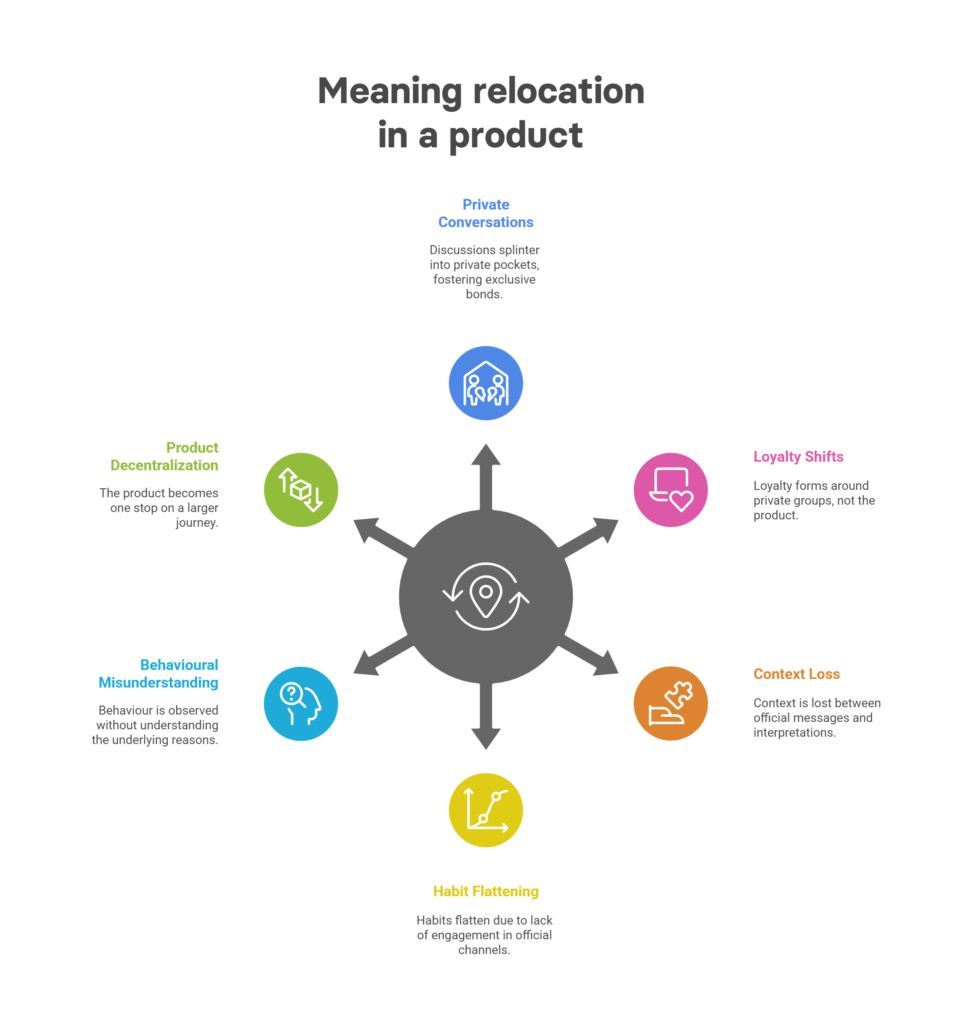
When that happens, things start shifting:
- Conversations splinter into private pockets.
- Loyalty forms around those pockets, not your product.
- Context gets lost between what you said and what people heard.
- Habits flatten because nothing pulls people back to keep talking.
- You see behaviour but not the why behind it.
- Your product stops being the centre and becomes one more stop on a bigger journey.
At bottom, belonging moves. Follows people to where they’re actually talking. Not where content lives. Not where announcements get posted. The room where everyone gathers to say, “Okay, what’s this really about?”
Leakage isn’t just “our stuff gets shared elsewhere.” It’s that meaning relocated. Once meaning moves, everything else slides with it.
Why “adding social features” doesn’t fix it
This is when someone usually says, “Fine, let’s add comments.” Or a chat tab. Reaction emojis. Something light, familiar, shippable.
The hidden assumption: drop in a social feature and social behaviour appears. Almost never true.
Comments aren’t community. Chat boxes aren’t real conversation. Emoji rows aren’t belonging.
Features let people express things. The deeper structure shapes how they behave.
Most products still run like delivery pipes. Publish, push, notify, done. Tuned for output. When teams add social stuff, they bolt it onto systems never built for back-and-forth. You get empty comment sections or ignored chats while real talk keeps happening in the usual side channels.
The core misunderstanding: a social layer isn’t a tool checklist. It’s how the product gets built so people can see each other, respond, build shared context, keep coming back.
Without that scaffolding, tools are decoration. You ship comments and important debates still unfold in private group chats you’ll never see. Stack on reactions and still have no clue where trust forms or breaks.
A product becomes truly social when people return not just for content but for what happens around it. The interpretations. The arguments. The slow messy work of making sense together.
That shift doesn’t start with a button. Starts with deciding your product isn’t just information delivery but a place where people sit with information together and talk it through.
The four components of a meaningful social layer
Peek under any place where people hang out and talk, you’ll see patterns. Not features (those change constantly). The little things that make a place feel alive.
Strip away logos, buttons, slick design. What’s left? A handful of basics helping people spot each other, follow the flow, figure out where they fit.
When these show up, the social layer just happens. Planned or not.

Visibility (Seeing and being seen)
People want to know they’re not alone. Not “who’s online” alone. The deeper “other humans share this space” alone. Catching signs someone was here before. Footprints, activity echoes, a pulse. Without it? Dead, flat. With it? Even silence feels alive.
Responsiveness (Things actually move)
Social places need pulse. Not constant noise. Rhythm. A nudge, a shift, something new. Like a dance. Frozen spaces feel like empty waiting rooms. People leave. Spaces that breathe pull you in.
Presence (Feeling someone’s close)
Seeing signs isn’t enough. Presence is different. The quiet knowing you’re sharing space with others even in silence. What gives you guts to jump in, react. Doesn’t need to be live. Slow spaces work too. About feeling the crowd moving through.
Interpretation (Making sense together)
At the heart: interpretation. Not just chatting. Working things out together, piece by piece. When one comment shifts everything. Threads stop being messages, become ways to figure stuff out. Doesn’t need depth or seriousness, just real enough to pull people back.
Put it together and you get something real. Not a checklist. A feeling. You’re seen, you follow the flow, others are near, you’re part of the story.
Miss one? The buzz moves somewhere else. Simple as that.
How to design the social layer in practice
Alright, so you get what makes a space feel social. Now what? It’s not about building something from scratch. More about rearranging what you’ve already got so people actually want to step in. Different teams will tackle this differently but the core stays the same: interpretation, movement, shared presence all happening inside your product instead of bleeding out somewhere else.
Let’s keep it real. No theories. No magic fixes. Just tactics that meet people where they are.
For publishers
News lives or dies on whether people come back. Not for more stories (everyone’s drowning in stories) but because they trust the rhythm. Want to ride the unfolding thing. A social layer helps but only if the editorial setup lets it breathe.

Easiest move? Treat stories like they’re alive. When something changes after you hit publish, readers lean in. Come back. Follow what’s happening. That “wait, it’s still unfolding” feeling builds anticipation without tricks. Same energy as live blogs or ongoing investigations. Story hasn’t landed yet.
Discussion spaces work when they’re built for meaning. Not noise. Don’t dump every chat into one massive box. Show people where real interpretation lives. When readers see others unpacking stuff thoughtfully (no shouting, no trolling), joining feels safer. Like stepping into a room the story shaped, not some random placeholder.
Quieter signals matter too. Saves, shares, repeat visits. Soft stuff that builds habit. When people sense others watching and thinking along, they stick around.
A news product with a social heart doesn’t feel like a file cabinet. Feels like a moving story you want to stay close to.
For brand communities
Brand communities don’t explode into existence. They grow slowly. Repetition. Little rituals. Predictable beats that whisper, “This is how we do things.”

Rituals don’t need drama. Weekly prompt. Shared challenge. Format where people show up their way. When members catch the pattern, they stop feeling like tourists. Start acting like they live there.
People want to show what a brand means to them. Not just talk about it. Show their style, progress, version of the story. Give room for that and you build texture. Skip it and you get a bulletin board.
Keep the energy inside your space. Make micro-interactions easy to jump into and people won’t wander off building their own thing elsewhere. They’ll leave their mark right there.
Good brand communities never feel like audiences waiting for the next announcement. Feel like neighbours who recognize each other by what they do and how they show up.
For internal comms
Internal communication only works if people can actually engage. Not just get blasted. The social layer makes that possible without everything turning into chaos.
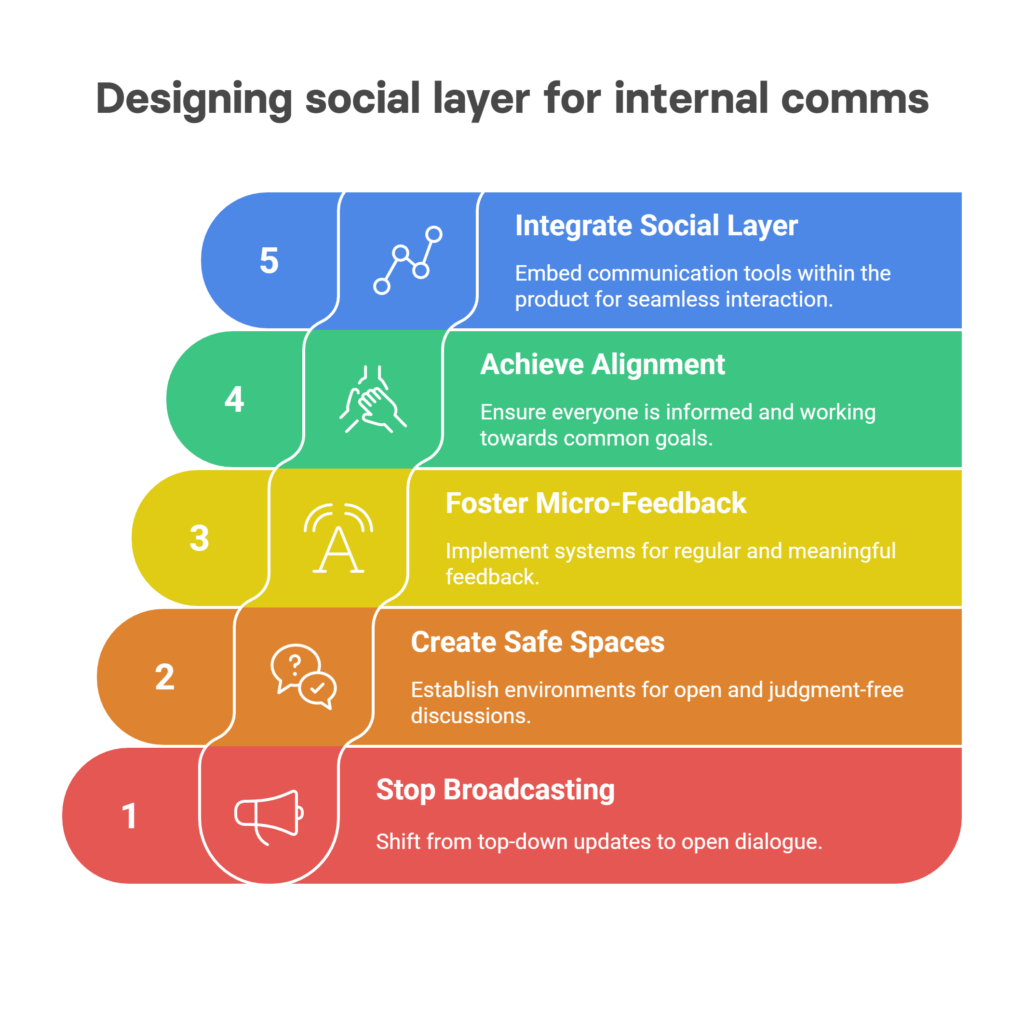
First move: stop broadcasting. Every top-down update with no room for response pushes people into side channels. Offer a space where questions get asked safely, reactions shared without judgment and the urge to build shadow networks drops.
Good internal spaces let people talk in order. Not wild debate, but real exchange. Psychological safety starts here. Where folks see others share the same doubts and confusion.
Micro-feedback loops help too. When people feel heard, when their voice doesn’t vanish into nothing, trust grows. Cuts confusion, kills misinterpretation, stops the quiet churn from not knowing what’s really happening.
Internal comms with a social feel doesn’t look like a dead noticeboard. Looks like a place people stay aligned because they can make sense of things together.
Designing the social layer isn’t about cranking up the volume. It’s about setting up the right spots for people to gather. Rhythms to follow. Signals to respond to. Get those pieces in place and all the private side-channel stuff starts happening where it belongs. Right inside your product.
What changes when the social layer is built in
Eventually this stops being theoretical and becomes very real: if you actually do the work of building a social layer into your product, what shifts?
Not vague stuff like “engagement improves.” Actual things. How people behave day to day.
You can spot it when you watch what starts happening, almost in the background.
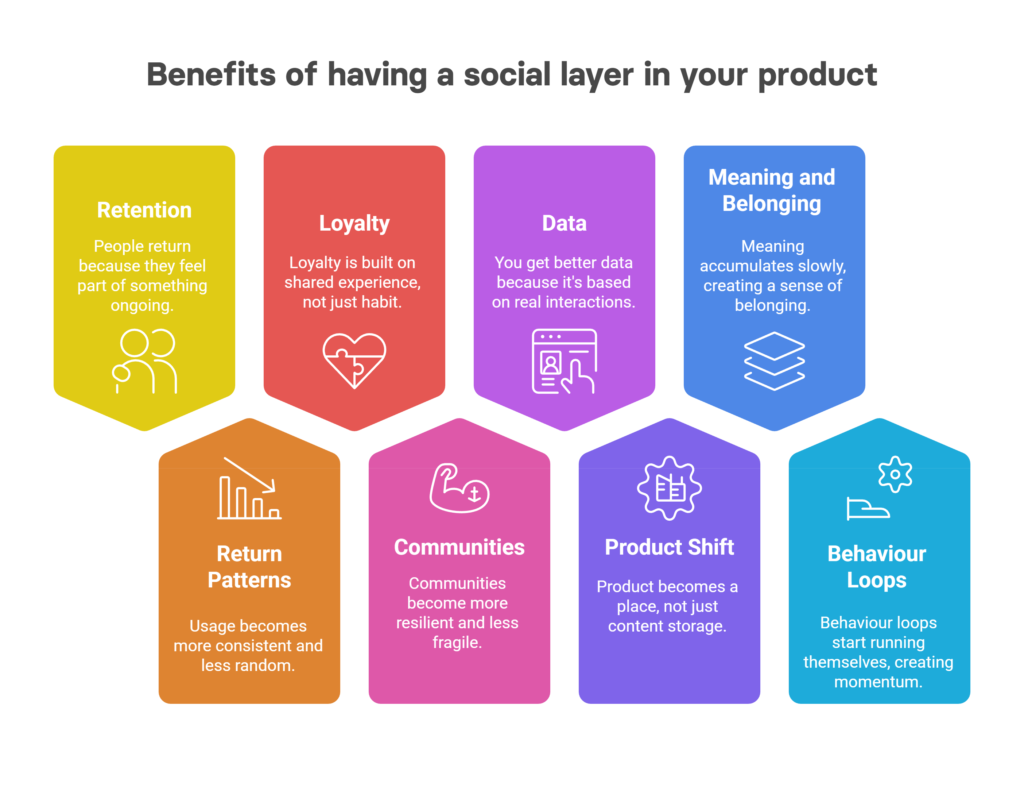
Retention becomes a side effect, not a goal
When people feel part of something ongoing, like they’re figuring stuff out together, they don’t need campaigns dragging them back. They just come back. Something’s moving and they’re already in it.
No more chasing spikes. You get steadier curves instead. People return to see what changed, how others responded, where things went next. The social layer turns coming back into habit. Not a metric someone’s trying to hit.
Return patterns stop looking random
Without a social layer, usage looks choppy. Surges when you launch something, then long stretches of quiet. With one in place? Different story. Product stops behaving like disconnected events. Starts feeling like a place people orbit.
Shows up in the numbers too. Not just how many visits. How reliably groups appear, how often conversations pull people back, how long threads stay alive. Less randomness because the reasons to return actually hold up.
Loyalty goes deeper than habit
Habit alone is fragile. Breaks the second something shinier appears. But loyalty built on shared experience? Way harder to shake loose.
When people feel they’ve shared a space with others, been through things there (a long unfolding story, a rough announcement, some collective win), the product gets tied to that memory. Not just using a tool. Attached to what it means in their rhythm.
Can’t buy that with rewards or perks. Grows out of interactions that feel human, repeated over time.
Communities become less fragile
Communities without a social layer inside the product tend to crack easily. Look solid when everything’s fine, disappear fast when attention moves.
When the social layer’s working, people have more than one way to stay connected. Know the patterns, the spots to show up, the threads holding things together. One format slows down? Another keeps the structure steady.
Resilience shows up in small ways. Conversations restart after quiet spells. Members jump in to keep things moving. People help each other stay oriented when stuff shifts. Space doesn’t collapse every time the spotlight drifts.
You get better data because it’s real interactions
Most analytics show what people did. Not how they felt doing it. A social layer doesn’t solve that magically, but gives you way more signal.
Start seeing the language people actually use with each other. Topics they voluntarily keep alive. Moments that pull lurkers into participating. Where confusion clusters, where trust builds, where it starts fraying.
That’s not click counting. That’s texture. Understanding the relationship between people and product. Clearer view of what’s actually working underneath.
Product shifts from content warehouse to actual place
No social layer? Your product’s basically storage. Stuff goes in, people grab it, leave. Might be polished, but stays flat.
Once the social layer’s built in, same product starts behaving like a real place. Familiar corners. Ongoing threads. Shared references. People who feel “from here” in ways that are hard to explain but easy to spot.
Notice when people start saying “in here” versus “over there” about your product. When they recommend it not just for what’s inside but for the feeling of being there with others.
Meaning and belonging start piling up
Meaning doesn’t land all at once. Accumulates slowly. A conversation that shifted someone’s perspective. A thread that made them feel less alone. A joke that keeps resurfacing.
When the social layer works, your product becomes one of the places where that accumulation happens. People carry history with the space. Remember being there for certain moments. That’s where belonging quietly forms. Not as some announcement, just as a slow build of “this is one of my places.”
Behaviour loops start running themselves
Early on, everything needs pushing. Content, campaigns, updates, reminders. Without a social layer, that never changes. Always pushing.
With one working? Some loops start feeding themselves. Someone drops a perspective, others respond, new questions pop up, fresh angle emerges, suddenly there’s momentum you didn’t manufacture.
Still guide. Still curate. But you’re not the only engine anymore. People using the product generate some of it themselves.
None of this turns your product into something it wasn’t. Just lets it become what people were already trying to make it outside where you could see: a place where they don’t just consume what you ship, but live with it, shape it, remember being there with others.
The inevitability of the social layer
Step back from your own product for a second. Look around at the bigger picture. This isn’t some nice-to-have design pattern anymore. The world changed in ways that make a built-in social layer less experiment, more necessity.
Lot of the assumptions that used to hold up digital strategy? They don’t anymore.
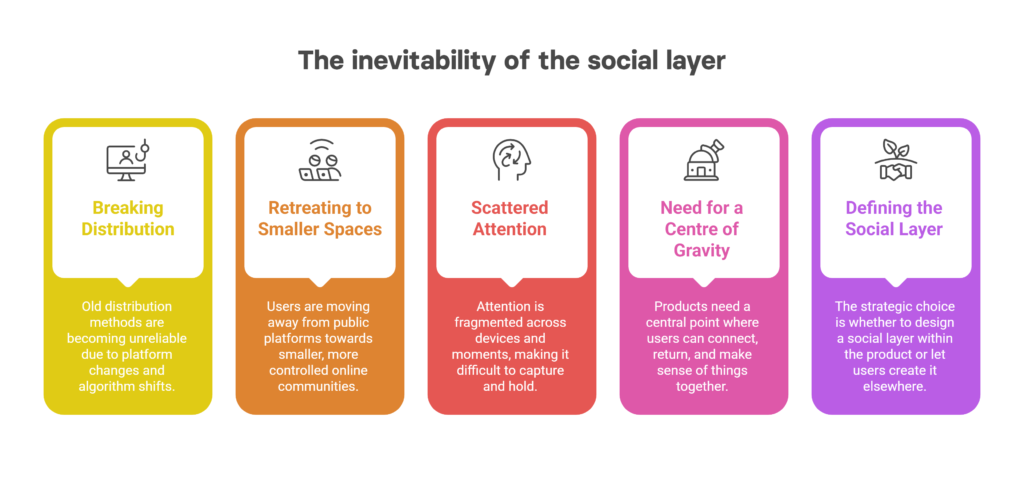
The old distribution playbook is breaking
For a long time, logic was simple. Build the product, let big platforms send people to it. Social feeds would surface your work. Search would catch the intent. Newsletters would plug gaps. Product itself could be fairly transactional because discovery and distribution got handled elsewhere.
That picture’s falling apart now.
Platform referrals are way more erratic. Algorithms shift without warning. Formats rise and collapse fast. What works one quarter looks dead the next. Search is getting messier. More cluttered results, more stuff sitting between you and the person who actually cares, more chaos in what surfaces and when.
Doesn’t mean those channels are useless. Just means they’re unreliable as your main engine. The external systems that used to carry people to you? Can’t be treated as stable infrastructure anymore.
When outside gets this unstable, inside has to do more heavy lifting.
People are retreating into smaller, tighter spaces
Meanwhile, user behaviour’s been drifting away from big public arenas. Toward smaller, more controlled ones. Group chats. Micro-communities. Private servers. Invite-only spaces. Online life shifted from open plazas to side rooms.
These micro-networks are where people feel most honest. Most relaxed. Most themselves. They share links there, sure. But more importantly they share interpretation. Build trust and meaning in those spaces. Not doing it to avoid your product. Doing it because that’s where social life feels real.
If your product doesn’t offer any sense of “this is one of my rooms,” it ends up being a stopover. People dip in. Extract what they need. Carry the real conversation back to places that feel like home.
Can’t fight that trend. What you can do? Recognize it. Design your product so it has its own rooms too.
Attention is no longer a single stream
Old idea of attention was basically: “Can we get people to look at us?” Made sense when there were fewer channels. When feeds moved in relatively linear ways.
Now attention’s scattered everywhere. Different devices. Different times of day. Different mental states. Different social setups. People don’t just “come online” and choose where to go. They drop in and out across dozens of micro-moments, with different groups, different intentions. In that landscape, trying to own attention outright? Losing game.
What you can own is something slightly different. A stable centre of gravity. Place in someone’s mental map that doesn’t disappear when algorithms shuffle the deck again. Product that has enough social weight inside it that people remember to go there, talk there, keep it in rotation.
Social layer is how that centre of gravity gets built.
Every product needs its own centre of gravity
When distribution was cheap and abundant, you could get away with a product that behaved purely like a container. Value sat in the content or feature set. User relationship lived somewhere else.
Now the opposite’s true. What differentiates you isn’t just what you publish or provide. It’s whether you’ve built a place inside the product where people can attach, return, make sense of things with others.
Center of gravity isn’t a branding exercise. It’s what happens when people know where to go inside the product when something important happens. Have a mental picture of “our space” there. Feel confident bringing others into that space. Trust that the history of their interactions lives there in a meaningful way.
Don’t get any of that from static experiences. Get it from environments where the social layer’s strong enough that people start leaning on it. Almost by instinct.
The decision is no longer whether you have a social layer
At this point, uncomfortable question isn’t “Should we build a social layer?” It’s “Are we willing to let everyone else define it for us?”
People will keep building their own micro-networks around what you do. Keep interpreting your work with others. Keep carrying your content into spaces that feel more human, more responsive, more grounded in their reality.
That’ll happen whether you design for it or not.
Strategic choice is whether you want some of that meaning-making and connection to happen inside your product, where it can strengthen loyalty and clarity. Or whether you’re content for it to live entirely elsewhere. Out of sight. Out of reach.
Because in the current environment, one thing’s more or less guaranteed: if you don’t design your social layer, your users will design one anyway. Just not with you in the room.
Where this leaves us
There’s a quiet shift hiding under all the dashboards and roadmaps. The products that matter to people? The ones that feel like places. Not pipes.
A place is somewhere you recognize even when nothing big is happening. You know how it sounds on a normal day. Roughly who might be there. What it feels like to walk in, even if “walking in” just means opening an app squeezed between two other things. Ordinary and specific at the same time.
Belonging doesn’t show up as polish at the end. Comes from how the thing’s built from the start. Small choices about where people can show up. How they can see each other. What they’re allowed to bring into the room. How easy it is to stay a bit longer than they planned. Can’t bolt that on after the fact. Shape it slowly, through how the product lets people be together around whatever it’s there to deliver.
Most teams still get rewarded for what they ship. Not for the spaces they quietly create. Easier to measure features than atmosphere. But if you pay attention to how people actually live with your product, almost all the important stuff? Grows out of the atmosphere.
So the real question isn’t whether you should “make your product social.” It’s simpler and harder. If this is going to be one of the places people carry around in their heads, what kind of place do you actually want it to be?




